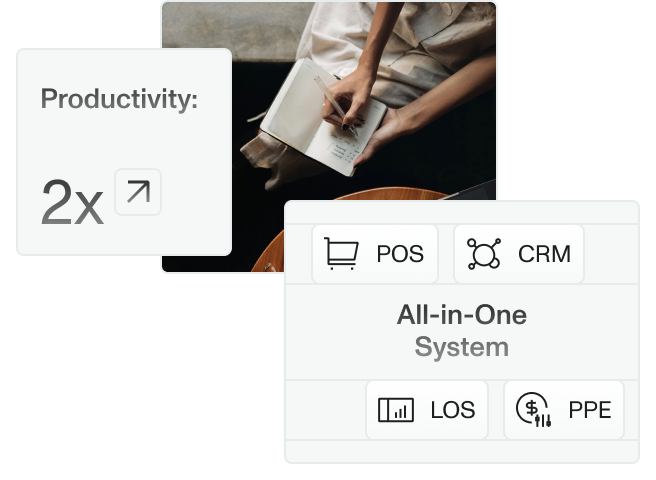The mortgage industry relies on multiple technologies. The most important is the increasingly sophisticated loan origination system (LOS).
A LOS software solution enables lenders to manage every stage in mortgage loan origination. Credit verification, documentation preparation, underwriting, and closing are automated through an LOS.
In this post, we’ll look at the evolution of loan origination systems in the mortgage industry and how they’ve transformed mortgage operations.
The Early Years
The earliest computerized loan origination systems were introduced in the early to mid-80s. They were clunky compared to today’s version and usually only offered loans from one lender. Still, the effect was immediate.
In 1984, the Wall Street Journal ran an article praising the new LOS and highlighting William Bolt, a man used to waiting six weeks or more for mortgage approvals. According to the Journal, Mr. Bolt was shocked when his mortgage banker utilized a LOS and approved the loan in two weeks.
LOS software was transformative, yet it still required significant manual labor. For instance, as software like point-of-sale systems developed, there was no way to connect the new tool to the LOS, meaning you had to store data on multiple systems. The lack of a single source of truth led to countless errors and miscommunications. Every loan application involved stacks of paper, numerous hand-offs between departments, telephone calls, and faxes.
The rise of better technology has led to monumental shifts, including a switch from tedious paperwork to electronic data processing. AI and machine learning (ML) technologies have been incorporated into digital LOS software over the past few years. This incorporation lets mortgage lenders analyze data and make decisions faster than before because automation can complete mundane and routine tasks.
Key Milestones in LOS Evolution
Several milestones have profoundly impacted how a LOS operates today.
Integration of Data Analytics
In responding to industry demand, the loan origination platform evolved into an analytical tool providing reliable market, risk, and ROI insights. The data-centric approach opened the door to more strategic decision-making in mortgage origination.
Adoption of Automation and Artificial Intelligence
LOS adoption of AI has changed from manual data entry to smart data verification, risk analysis, and even predictions. Natural language processing (NLP) and machine learning (ML) algorithms can automate complex underwriting protocols, reducing closing time.
CEO of Sonar Chris de la Motte says incorporating loan origination automation is necessary for mortgage professionals. It optimizes workflow and increases precision with tools like optical character recognition (OCR) technology that scans documents.
Transition to Cloud-Based Platforms
Another development in LOS technology is the move to cloud-based platforms. These more flexible LOS solutions offer real-time collaboration and more accessible system updates.
Impact of Advanced LOS on Mortgage Operations
Today’s LOS is a unified platform. Borrowers input their information directly, and the data is instantly available through each step of origination, from application to closing. You don’t have to chase data stored in disparate systems, reducing operational costs.
There are also clear efficiency gains. With reduced manual effort, there’s a significant reduction in processing times so that loan officers can handle more cases with the same or fewer resources.
The most critical aspect of the LOS is its ability to provide a better experience for borrowers. Advanced LOS offerings include borrower portals, where applicants can track their loan’s progress and communicate with their loan officer.
Challenges and Considerations
Of course, switching to a sophisticated LOS brings challenges, too. Maintaining regulatory compliance is critical; you need the proper LOS to help you do that. Lenders are under increasing pressure to protect user data.
Integration
Ideally, your move toward a new LOS should not disrupt the existing ecosystem. You want to find software that integrates with tools such as your product pricing engine (PPE) and customer relationship management (CRM) solutions.
A LOS without integration capabilities is far less valuable and might lead to data duplication.
Training
Even the most advanced LOS can be rendered ineffective by poor use. Effective training keeps your team on board with the new system.
Future Trends and Innovations in LOS Technology
The trajectory of LOS technology is heading toward increased automation and digitalization. Here’s a glimpse into what the future might hold.
Implementing Predictive Analytics and Machine Learning
With the proliferation of data, LOS software has become more prescriptive. Machine learning and AI can better predict borrower behavior and default risks, allowing more diverse borrower profiles to obtain loans.
The Personalization and Customization of LOS
The demand for faster and improved borrower experiences leads LOS designers to offer more customization and personalization, tailoring loan products and services to individual needs.
In 1984, experts raved about the new computerized loan origination system. Forty years later, LOS technology is even more impressive and continues to transform mortgage lending dramatically. And as AI and ML become more prevalent, we can expect greater efficiency, accuracy, and personalization.
It’s crucial to stay up-to-date on mortgage trends and be ready to adopt new, effective software. By embracing LOS advances, mortgage professionals can promise borrowers a seamless experience.
Consider upgrading to more modern loan origination systems like Sonar. You can book a demo today to see for yourself how Sonar is one of the leading platforms in the new wave of LOS technology.







